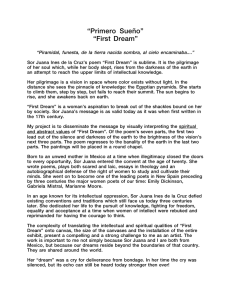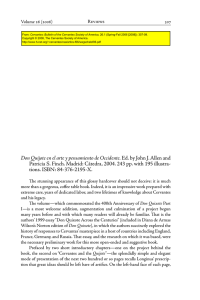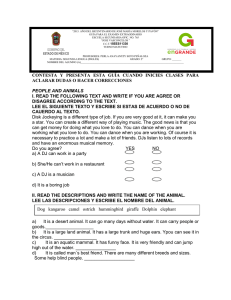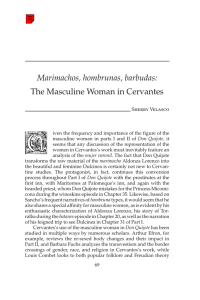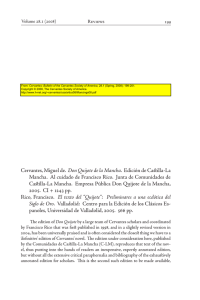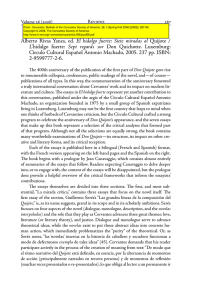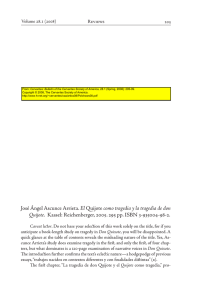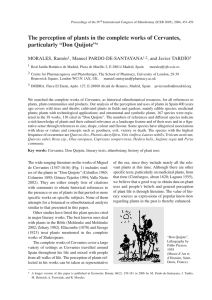The Reluctant Companion of Empire - H-Net
Anuncio
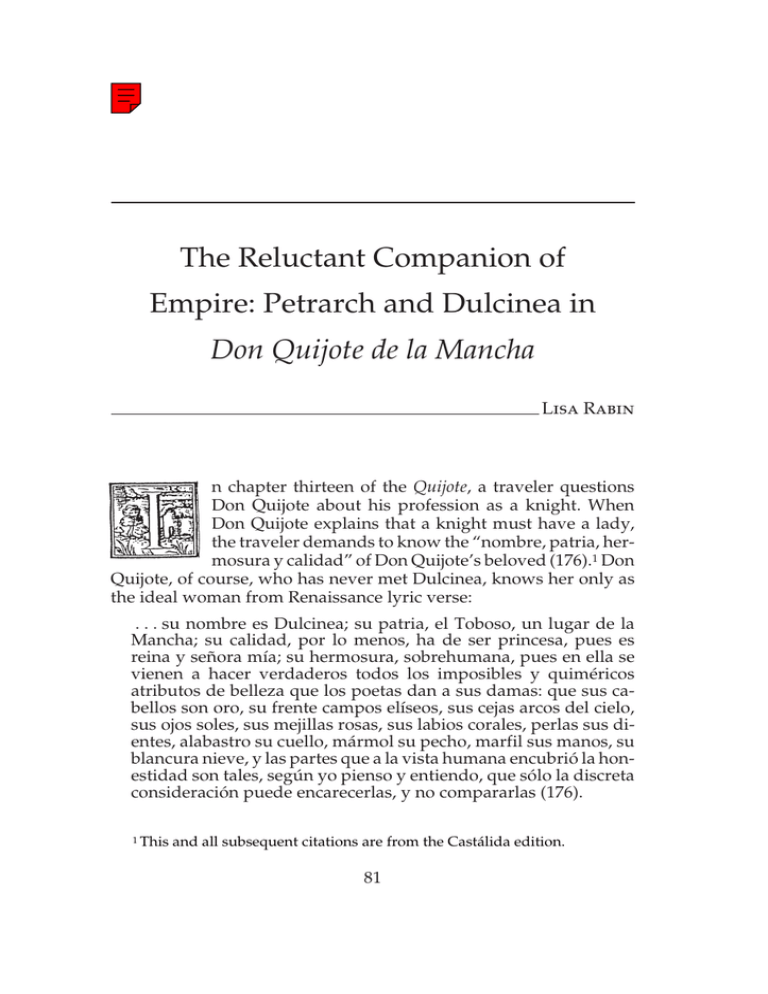
The Reluctant Companion of Empire: Petrarch and Dulcinea in Don Quijote de la Mancha Lisa Rabin n chapter thirteen of the Quijote, a traveler questions Don Quijote about his profession as a knight. When Don Quijote explains that a knight must have a lady, the traveler demands to know the “nombre, patria, hermosura y calidad” of Don Quijote’s beloved (176).1 Don Quijote, of course, who has never met Dulcinea, knows her only as the ideal woman from Renaissance lyric verse: . . . su nombre es Dulcinea; su patria, el Toboso, un lugar de la Mancha; su calidad, por lo menos, ha de ser princesa, pues es reina y señora mía; su hermosura, sobrehumana, pues en ella se vienen a hacer verdaderos todos los imposibles y quiméricos atributos de belleza que los poetas dan a sus damas: que sus cabellos son oro, su frente campos elíseos, sus cejas arcos del cielo, sus ojos soles, sus mejillas rosas, sus labios corales, perlas sus dientes, alabastro su cuello, mármol su pecho, marfil sus manos, su blancura nieve, y las partes que a la vista humana encubrió la honestidad son tales, según yo pienso y entiendo, que sólo la discreta consideración puede encarecerlas, y no compararlas (176). 1 This and all subsequent citations are from the Castálida edition. 81 82 Lisa Rabin Cervantes Don Quijote’s portrayal of Dulcinea is known as the blasón, a Renaissance convention that describes the lady as a series of parts. The blasón was derived from medieval sources, was first employed in the Renaissance epic, and became codified in the lyric with Petrarch’s Rime sparse (1374).2 Although we never get a complete picture of Petrarch’s Laura, we recognize her teeth as pearls, her hair as gold knots, and her lips as red as coral. Dulcinea is the incarnation of Petrarch’s lady. Don Quijote, moreover, is the consummate Petrarchan poet. In the Rime sparse, the blasón is a product of Petrarch’s unrequited love for Laura. Because the poet’s desire for her is never fulfilled, her whole body is never described. This is central to Petrarch’s strategy: as he describes the lady’s beautiful parts, so he can paint the contours of his internal world. In the following famous poem from Petrarch’s collection, Laura’s hair and eyes “kindle” his desire: Erano i capei d’oro a l’aura sparsi che ‘n mille dolci nodi gli avolgea, e ‘l vago lume oltra misura ardea di quei begli occhi, ch’ or ne son sì scarsi; e ‘l viso di pietosi color farsi (non so se vero o falso) mi parea: i’ che l’esca amorosa al petto avea, qual meraviglia se di subito arsi? (Petrarch, Rime sparse 90)3 The spark of the lady’s features (“mille dolci nodi”, “ ‘l vago lume oltra misura ardea”) causes the poet’s desire to catch fire (“di subito arsi”). The poet’s desire is both sexual and creative: Laura so inspires 2 Bembo, who considered Petrarch’s vernacular style to be as good as classical poetry, is responsible for canonizing Petrarch’s blasón in the lyric (Cropper 1976, 390). See Nancy Vickers’ dissertation, Preface to the Blasons Anatomiques: The Poetic and Philosophic Contexts of Descriptions of the Female Body, for a history of the blasón in poetry. Elizabeth Cropper’s “On Beautiful Women, Parmigianino, Petrarchismo, and the Vernacular Style” examines the uses of the poetic blasón in painting. The finest general criticism of Petrarch’s poetics includes Durling’s introduction to the Rime, John Freccero’s “The Fig Tree and the Laurel: Petrarch’s Poetics”, and Giuseppe Mazzotta’s “The Canzoniere and the Language of the Self”. 3 This citation is from the edition of Durling. 14 (1994) The Reluctant Companion of Empire 83 Petrarch that her body parts literally become poetic language.4 Indeed, his beloved must always be a blasón (or permanently unattainable) for Petrarch to write beautiful poetry. In a similar way, Dulcinea must always exist as a blasón for Don Quijote to pursue his epic fantasies. This is illustrated in the exchange between Sancho and Don Quijote in chapter thirty. The squire has been begging Don Quijote to marry Dorotea, whom he believes to be a princess. Sancho argues that Dorotea must be as beautiful as Dulcinea, since he has never set eyes on Don Quijote’s lady. Don Quijote then interrupts Sancho, accusing him of lying: how could the squire not have seen the lady, if he has just delivered a letter from her to Don Quijote? Defending himself, Sancho cleverly explains the subtleties of viewing the lady: “Digo que no la he visto tan despacio . . . que pueda haber notado particularmente su hermosura y sus buenas partes punto por punto; pero así, a bulto, me parece bien” (378–379). Sancho, in other words, cannot report having “seen” Dulcinea if he is not able to describe her in her parts. Don Quijote easily accepts this defense, since it is only by Dulcinea’s “buenas partes” that he himself knows her. The blasón is thus a central topic of the novel: just as Petrarch’s poetry depends on the fragmentation of Laura’s body, Don Quijote’s blasón of Dulcinea is fundamental to his heroic efforts. Indeed, in chapter ten of the second part, when Don Quijote discovers that Dulcinea is a peasant woman, his ambition is never the same again. Without the Petrarchan beloved, Don Quijote’s entire project collapses, and he becomes disillusioned and dies. Thus while in Petrarch ideal love allows the poet to explore his internal world, for Don Quijote, love leads to outside adventure. The association between epic deeds and Petrarchism in Cervantes’ text is very important. Petrarch’s Rime helped to inspire vernacular lyric traditions in Italian and other European languages.5 In Golden Age Spain, the introduction of Petrarch’s lyric accompanied 4 As Vickers 1982 points out, the Rime sparse, or “scattered rhyme”, are Petrarch’s scattering of the woman’s body throughout the text (109). 5 In the fourteenth and fifteenth centuries, Petrarch’s style was instrumental in the campaign for linguistic and national unity in Italy. In his Prose della volgar lingua (1525), Bembo establishes Tuscan as the appropriate vernacular style, emphasizing the “arcane” forms of Petrarch, Boccaccio and other authors of the trecento as important models (Migliorini, 211–213). See Leonard Forster’s The Icy Fire: Five Studies in European Petrarchism for a discussion of the international adoption of Petrarchism in the Renaissance. 84 Lisa Rabin Cervantes both the promotion of Castilian and the political expansion of the crown in America (González Echevarría 1993, 1). The Renaissance Spanish courtier often wore two hats—that of a soldier, politician or cleric, and that of a Petrarchan poet. Military officers like Garcilaso de la Vega (and even Hernán Cortés) were also poets. Members of court society or the Church, like Quevedo and Sor Juana, were well known for their lyric verse. In Golden Age texts, the desire for a beautiful, unattainable beloved is often coupled with aspirations of empire. Not only Don Quijote frames his adventures with Petrarchan praise for the beloved. Columbus portrays the Western Hemisphere as a woman’s breast: . . . falle que (el mundo) no era redondo en la forma que escriben, salvo que es de la forma de una pera que sea toda muy redonda, salvo allí donde tiene el pezón, que allí tiene más alto, o como quien tiene una pelota muy redonda y en un lugar de ella fuese como una teta de mujer allí puesta. (Columbus, 181)6 And in Góngora, the lady’s eyes are given power over Spain and its overseas empire: “Divinos ojos, que en su dulce Oriente / dan luz al mundo quitan luz al cielo, / y espera idolatrallos Occidente” (Góngora 13).7 In these texts, the Petrarchan desire to possess the woman translates into a desire to possess new territory.8 The blasón thus serves to kindle not only erotic fantasies, but also epic ones in the Spanish Golden Age: “love” is a mere pretext for leaving home. Antonio de Nebrija declared in his prologue to Queen Isabella in the Gramática de la lengua castellana, “siempre la lengua fue compañera del imperio”.9 More precisely, however, the true companion of the Spanish empire is the Petrarchan beloved. For Don Quijote, Garcilaso, Columbus and Góngora, the Petrarchan lady’s sensuality is the site of heroic aims. But what happens, as in the Quijote, when the beloved proves to be quite far from the Petrarchan ideal? In chapter ten, part two, in the famous scene of the “enchanted” Dulcinea, the peasant woman whom Sancho identifies as Don Quijote’s lady is clearly neither beautiful nor discrete. Rather, she is ugly, rude and (most startling of all) speaks up for herself. 6 Los cuatro viajes del Almirante y el Testamento, edition Anzoátegui. citation is from the collection of Poesía, edition Blecua. 8 Zamora uses the example of Columbus and the woman’s breast to point out the author’s frequent use of gender difference to create a position of superiority in relation to the New World. (173–174). 9 This citation is from the edition of Galindo Romero. 7 This 14 (1994) The Reluctant Companion of Empire 85 While Don Quijote thinks his beloved has been possessed by evil enchanters, the peasant woman is merely refusing to be possessed by Petrarchan poets. Cervantes’ comic staging of the Petrarchan blasón creates a brilliant confrontation between male and female speech in this scene.10 The clash between Don Quijote’s Petrarchan ideal and the reality of the peasant woman interrupts his campaign— profoundly recasting the Golden Age alliance between Petrarchan love and imperial design. From the beginning of the novel, Cervantes has been carefully preparing his burlesque of the blasón. For example, although she is always a creature of parts, Dulcinea’s ideal qualities are often described with base metaphors from her peasant environment. In chapter four, Don Quijote characterizes Dulcinea’s eyes as dripping “ámbar y algalia entre algodones”, and her posture as “más derecha que un huso de Guadarrama” (101). And Sancho, in the famous scene of the “enchanted” Dulcinea, describes the lady’s parts as even more mundane, blaming her transformation on the evil enchanters: Bastaros debiera, bellacos, haber mudado las perlas de los ojos de mi señora en agallas alcornoqueñas, y sus cabellos de oro purísimo en cerdas de cola de buey bermejo y, finalmente, todas sus faciones de buenas en malas, sin que le tocárades en el olor; que por él siquiera sacáramos lo que estaba encubierto debajo de aquella fea corteza; aunque, para decir verdad, nunca yo vi su fealdad, sino su hermosura, a la cual subía de punto y quilates un lunar que tenía sobre el labio derecho, a manera de bigote, con siete u ocho cabellos rubios como hebras de oro y largos de más de un palmo (112). Here, Cervantes ingeniously redeems the baseness of the lady’s features by having Sancho describe the hairs of Dulcinea’s mole as “hebras de oro”, a clear echo of Petrarch.11 When Cervantes’ spoof of the blasón reaches its climax in chapter ten of the second part, Sancho has identified Don Quijote’s lady 10 As Auerbach points out in his famous essay on “The Enchanted Dulcinea,” the key issue in this episode is the distinction between the woman’s speech and Don Quijote and Sancho’s exalted words for her (Auerbach, 339). Auerbach rightly interprets Don Quijote’s praise of Dulcinea as part of the common discourse of chivalresque novels (including aspects of Platonic love, courtly love poetry, and Dante). Yet Auerbach significantly fails to recognize Cervantes’ critique of Petrarchan convention in this scene. 11 Sancho’s use of this sort of language in the blasón is in the tradition of the anti-blasón that becomes popular in the Renaissance. Shakespeare, for example, in Sonnet 130 speaks of the “ black wires” on his lady’s head and her “breath that . . . reeks” (Shakespeare’s Sonnets, edition Ingram and Redpath). 86 Lisa Rabin Cervantes as one of a group of peasant women who approach them on mules. In this scene, the lofty language of the blasón is openly challenged by the coarse words of the woman herself. As they wait for the peasant women’s approach, Sancho prepares Don Quijote with a Petrarchan image: verá venir a la princesa, nuestra ama, vestida y adornada; en fin, como quien ella es. Sus doncellas y ella todas son una ascua de oro, todas mazorcas de perlas, todas son diamantes, todas rubíes, todas telas de brocado de más de diez altos; los cabellos sueltos por las espaldas, que son otros tantos rayos del sol que andan jugando con el viento; . . . (108) In order to gain the women’s attention, Sancho showers them with Petrarchan praise. Yet one of the women, far from being impressed, talks back to him: “¡Mirad con qué se vienen los señoritos ahora a hacer burla de las aldeanas, como si aquí no supiésemos echar pullas como ellos! Vayan su camino, y déjenmos hacer el nueso, y serles ha sano” (110). The woman’s complaint is significant: for her, Don Quijote and Sancho’s blasón is far from complementary; it is, instead, a “pulla”, or an insult. In addition, the woman brags, she can dish out the abuse just as well as they. Both men are dumbfounded by the lady’s rejection. When Don Quijote becomes dejected by the woman’s words, Sancho consoles him by claiming that Dulcinea is enchanted. Don Quijote then resolves to disenchant Dulcinea, a goal that moves the rest of the novel. At the end of the story, when Don Quijote realizes that Dulcinea will not be disenchanted, he becomes disillusioned and dies. The parody of Don Quijote and Sancho in this passage is similar to Cervantes’ commentaries on chivalresque, pastoral, and picaresque texts in the Quijote. In the scene of the “enchanted” Dulcinea, Petrarchan lyric is held up as a now time-worn convention. In the words of the peasant woman, the blasón has already been heard before, many times. The idealized parts of the blasón are no longer appropriate to describe the lady; she is, rather, both completely intact and very mundane. What is more, she talks back to Don Quijote, further disturbing his vision of an indifferent beloved. As Dulcinea’s real-life persona challenges Don Quijote’s ideals, she simultaneously also unsettles cultural pretensions of empire. When Don Quijote is unable to “disenchant” Dulcinea, he has no more companion—or, to use Nebrija’s terms, no more language— with which to pursue his adventures. Denied of the blasón, Don Quijote is denied his Petrarchism, or his other hat, and he wastes away. 14 (1994) The Reluctant Companion of Empire 87 The Petrarchan companion is clearly essential to the pursuit of epic deeds. If the lady were a poet of “pullas” and a hero of her own adventures, Cervantes points out, what sort of new quest (or new text) would we find ourselves in? Cervantes’ interjection of the female imagination into the Petrarchan blasón is enhanced when we compare the enchanted Dulcinea to a blasón of Sor Juana Inés de la Cruz. Sor Juana was a woman poet and nun in colonial New Spain. All her life, she struggled to find her own authority amidst the repressive social and religious environment of the colonial world, as well as within the influence of Renaissance rhetorical models.12 Yet Sor Juana found refuge in the intimacy of Petrarchan poetry, which she used as political praise for her patrons. As Sor Juana expresses “love” for these women in this poetry, she is also expressing a desire for her own political subjectivity.13 In poem 80 of Sor Juana’s lyric collection, she reveals a keen critical position on both Petrarchism and imperialism. In this poem, Sor Juana’s third patron, the vicereine the Condesa de Galve (“Elvira”), is praised in a fascinating blasón. The lady’s parts are a triumphalist, linear history of imperial heroes: Con los Héroes Elvira mi amor retrata, para que la pintura valiente salga. Ulises es su pelo, con Alejandro: porque es sutil el uno, y el otro largo. Un Colón es su frente por dilatada, 12 The best criticism on Sor Juana’s life and work includes Marie-Cécile Bénassy-Berling’s Humanisme et religion chez Sor Juana Inés de la Cruz: La femme et la culture au XVIIe siècle, Frederick Luciani’s The Courtly Love Tradition in the Poetry of Sor Juana Inés de la Cruz, Octavio Paz’ Sor Juana Inés de la Cruz o las trampas de la fé and Georgina Sabàt de Rivers’ Estudios de literatura hispanoamericana: Sor Juana Inés de la Cruz y otros poetas barrocos de la colonia. 13 “. . . a desire for her own political subjectivity”: For a study of Sor Juana’s political Petrarchism, see my dissertation, the Petrarchan Poetics of Sor Juana Inés de la Cruz. 88 Lisa Rabin Cervantes porque es quien su Imperio más adelanta. A Cortés y Pizarro tiene en las cejas, porque son sus divisas medias Esferas. (Sor Juana 80)14 Sor Juana’s description of Elvira with epic heroes literally reproduces the cultural subtext of the Golden Age blasón: the lady’s body parts are the locus of epic as well as erotic fantasies. Yet this blasón is very different from the poems of Columbus and Góngora. Like Dulcinea who has her say with Don Quijote, Elvira is another reluctant companion of empire. At the beginning of this poem, Sor Juana hopes that that her portrait of Elvira appear “valiente”. The poet desires, in other words, that Elvira be considered an equally viable hero as Cortés or Pizarro. The vicereine is clearly the latest in a long line of historical figures, since she has her own “Imperio”. Yet at the same time, Elvira remains a creature of beautiful parts. As the poem progresses, we see that the tension between Elvira’s political fame and her ideal beauty precludes Sor Juana from describing the lady’s more delicate parts: A su boca no hay Héroe, porque no encuentro con alguno que tenga tan buen aliento. (. . . . ) Los pies, si es que los tiene, nunca los vide; y es que nunca a un Valiente los pies le sirven. Sor Juana cannot find an appropriate hero for the lady’s mouth, since none have her sweet breath. Here, Elvira is clearly a Petrarchan lady and not an epic hero. But at the same time, the blasón includes no feet for Elvira because “nunca a un Valiente / los pies le sirven”. In this verse, Elvira is an epic hero, and thus cannot take on the feet of the Petrarchan beloved. The contradictions of this poem pose an interesting dilemma: how can the lady be the hero of an empire that sees her as its very object? 14 This citation is from the edition of Méndez Plancarte (see bibliography). 14 (1994) The Reluctant Companion of Empire 89 It is no wonder that Sor Juana is uncomfortable writing a blasón of the vicereine in this poem. Conventional representations of both the woman and epic hero are mutually exclusive when the hero is a woman. And because Elvira is a colonial woman hero, she lies even further beyond the imagination of Spanish Golden Age culture. In her inability to describe Elvira’s intimate parts, Sor Juana preserves her patron’s “privacy”, or authority, within official paradigms of poetry and history. The blasón of Elvira, the amalgam of epic hero and Petrarchan beloved, is closely associated with the unrefined words of the “enchanted” Dulcinea. In Cervantes and Sor Juana’s texts, the desire for new worlds and new territory is no longer satisfactorily contained in the woman’s body. Dulcinea’s words “Vayan su camino, y déjenmos hacer el nueso” mark a crucial distinction between the peasant woman’s language and the language of Don Quijote’s Petrarchan blasón. This statement shows that there is a “camino” beyond the projections of the blasón, or a place where the woman is distinguished for her own epic proportions, instead of her physical ones. The imperfect blasón of Elvira, meanwhile, signifies an “Imperio” for Sor Juana’s patron that extends beyond both triumphalist historiography and the Petrarchan imagination. Ultimately, just as the blasón inhibits the portrayal of the woman, it is also confining to poets themselves.15 To Dulcinea Don Quijote’s blasón is mere “pullas”: he is a conventional Petrarchan poet, and sounds like all the rest. This criticism is a profound one, bypassing everyone else’s humorous judgment of Don Quijote’s madness. Indeed, when the lady is no longer ideal, Don Quijote must confront the limits of his creativity. Because he has no room for the real-life peasant woman in his fantasy, his adventure ends. In a similar way, when Elvira’s parts cannot fit into either a Petrarchan poem or a triumphalist historiography, both poetry and history are the lesser for her absence. Cervantes and Sor Juana’s critiques of Petrarchism question central presumptions of the Spanish Golden Age, suggesting that both desire and adventure entail more than the mere exchange of two hats. 15 Lauren Silberman’s “Singing Unsung Heroines: Androgynous Discourse in Book 3 of The Faerie Queene” has been helpful to me here. In the Faerie Queene, Spenser suggests that male Petrarchan poets “in their proper prayse too partiall bee” (3.2.1, edition J. C. Smith, as quoted in Silberman, 259). The poet’s incomplete or “partial” praise of the beloved in her beauty results only in a “partial” or biased view of the poet himself (Silberman, 260). Works Cited Auerbach, Erich. 1953. “The Enchanted Dulcinea”. In Mimesis: The Representation of Reality in Western Literature, trans. Willard R. Trask, Princeton: Princeton University Press: 334 –358. Bénassy-Berling, Marie-Cécile. 1982. Humanisme et religion chez Sor Juana Inés de la Cruz: La femme et la culture au XVIIe siècle. Paris: Publications de la Sorbonne, editions hispaniques. Spanish edition 1983. Humanismo y religión en Sor Juana Inés de la Cruz. México: Universidad Nacional Autónoma de México. Brault, Gerald. 1972. Early Blazon. Oxford: Clarendon Press. Colón, Cristóbal. 1986. Ed. Ignacio Anzoátegui. Los cuatro viajes del Almirante y su testamento. Madrid: Espasa-Calpe. Cervantes Saavedra, Miguel de. 1986. Ed. Luis Andrés Murillo. El ingenioso hidalgo Don Quijote de la Mancha, vols. I y II. Madrid: Clásicos Castálida. Cropper, Elizabeth. 1976. “On Beautiful Women, Parmigianino, Petrarchismo, and the Vernacular Style”. The Art Bulletin 58: 374–94. Durling, Robert, ed. 1976. Petrarch’s Lyric Poems: The Rime sparse and other Lyrics. Cambridge: Harvard University Press. Forster, Leonard. 1969. The Icy Fire: Five Studies in European Petrarchism. Cambridge: Cambridge University Press. Freccero, John. 1975. “The Fig Tree and the Laurel: Petrarch’s Poetics”. Diacritics 5:34–40. Góngora, Luis. 1979. Ed. José Manuel Blecua. Poesía. Zaragoza: Ebro. González Echevarría, Roberto. 1993 ms. “Colonial Lyric.” To appear in the Cambridge History of Latin American Literature. Cambridge: Cambridge University Press. Ingram, W. G. and Theodore Redpath, eds. 1964. Shakespeare’s Sonnets. London: University of London Press. 90 14 (1994) The Reluctant Companion of Empire 91 Luciani, Frederick. 1982. The Courtly Love Tradition in the Poetry of Sor Juana Ines de la Cruz. Yale University dissertation, 1982. Ann Arbor: UMI. 8221423. Mazzotta, Giuseppe. 1976. “The Canzoniere and the Language of the Self.” Studies in Philology 75:271–296. Migliorini, Bruno. 1966. The Italian Language. New York: Barnes and Noble. Nebrija, Antonio de. 1946. Eds. Pascual Galindo Romeo y Luis Ortíz Muñoz. Gramática castellana. Madrid: Edición de la Junta del Centenario. Paz, Octavio. 1982, third edition 1985. Sor Juana Inés de la Cruz o las trampas de la fé. Barcelona: Seix Barral. English language edition, 1988. Trans. Margaret Sayers Peden. Sor Juana, or The Traps of Faith. Cambridge, Mass. Rabin, Lisa. 1993. The Petrarchan Poetics of Sor Juana Inés de la Cruz. Unpublished Yale University dissertation, 1993. Sabàt de Rivers, Georgina. 1992. Estudios de literatura hispanoamericana: Sor Juana Inés de la Cruz y otros poetas barrocos de la colonia. Barcelona: PPU. Schmidt, Albert-Marie, ed. 1953. “Blasóns du corps fémenin”. In Poètes du XVIe siecle. Paris: Gallimard. Silberman, Lauren. 1986. “Singing Unsung Heroines: Androgynous Discourse in Book 3 of The Faerie Queene”, in Rewriting the Renaissance, eds. Margaret W. Ferguson, Maureen Quilligan, and Nancy J. Vickers: 259–271. Chicago and London: University of Chicago Press. Sor Juana Inés de la Cruz. 1951–1957. Ed. Alfonso Méndez Plancarte. Obras completas: 4 volúmenes. I. Lírica personal. II. Villancicos y letras sacras. III. Autos y loas. IV. Teatro profano y prosa (ed. Alberto G. Salceda a la muerte de Méndez Plancarte). Mexico-Buenos Aires: Fondo de Cultura Económica. Spenser, Edmund. 1909. Ed. J. C. Smith. The Poetical Works of Edmund Spenser. Oxford: Clarendon Press. Vickers, Nancy. 1976. Preface to the Blasons Anatomiques: The Poetic and Philosophic Contexts of Descriptions of the Female Body. Yale University dissertation, 1982. Ann Arbor: UMI. 770045. ———. 1982. “Diana Described: Scattered Woman and Scattered Rhyme”. Rpt. in Writing and Sexual Difference, ed. Elizabeth Abel, 95–109. Chicago: The University of Chicago Press. Zamora, Margarita. 1993. Reading Columbus. Berkeley and Los Angeles: University of California Press.
